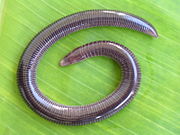|
Date & Time : 22, December 2024 17:30
General Characteristics of Amphibia
- skin is rich in glands to keep it moist.
- scales whenever present are hidden in the skin.
- skull consist of two occipital condyles.
- limbs are tetrapodous pentaductyle type.
- R.B.C. are biconvex, nucleated and oval in shape.
- eggs are usually laid in water.
Classification of Amphibia
A Few Examples
Uraeotyphlus
Geographical distribution: India, South Africa, Malay, Malabar hills and South America
Food: worms
 Uraeotyphlus interruptus habitus Characters:-
1. Burrowing, elongated vermiform and cylindrical form
2. Body:
a. dorsally – dark green or brown or black
b. ventrally – white
3. Skin is grooved transversely and contain cycloid scales
4. Small and conical head
5. Lidless eyes covered by skin
6. limbs and limb girdles absent
7. tail – short or vestigial
8. terminal cloaca
Salamandra
Common name: European fire-salamander
Geographical distribution: Europe and Asia
Habitat : terrestrial
Characters:-
1. Lizard like body
2. Body colour: yellow with black spots
3. Well- developed and strong limbs
4. Cylindrical tail
5. In adults gills absent
6. Movable eyelids
7. Absence of tympanic membrane or middle ear
8. Parotid glands present behind the head
9. Presence of teeth on both jaws
10. Vomerine teeth present
11. Opisthocoelous vertebrae
12. Reproduction :-viviparous
a. Development of 15 embryos occur in oviducts
b. Young – ones have external gill slits and metamorphosis occur later
Necturus
Common name: mud puppy
Geographical distribution: North America and Yugoslavia
Habitat: permanently aquatic
Characters:-
1. Body elongated – 30-42cm in length
2. Body colour rusty brown with blackish spot
3. Long tail with caudal fin
4. Necturus is typical neotenic larva
5. Lungs present
6. Jacobson organ absent
7. Larval Characters:-
a. External gills:- 3 pairs in adult
b. Gill clefts: open and 2 in pairs
c. Lidless eyes
d. Large cartilaginous skull
e. Musculature larva
f. Larval circulatory system
g. Presence of lateral line organ
Bufo
Common name: true - toad
Geographical distribution: all over world except Australia and Madagascar
Habitat: terrestrial and nocturnal
Food: carnivorous, feed on insects ,worms and snails
Characters:- 1. Skin – rough ,dry and watery dorsally
2. Large eyes
3. Small nostrils
4. Well – developed tympanum
5. Presence of parotid gland behind tympanum .It secrete irritating poison fluid
6. Fore-limbs: 3 webless fingers and thumb pad
7. Hind limb: 3 toes with reduced web
8. Teeth absent
9. Procoelous vertebrae
10. Ribs and sternum absent
11. Reproduction: eggs laid in water in strings
Hyla
Common name: Tree frog
Geographical distribution: cosmopolitan in damp forests except India and Africa
Habitat: arboreal
Characters:-
1. Skin:-smooth on dorsal surface and has papillae on ventral surface
2. Length: 2.5 – 7.5cm
3. Well – developed eyes , tympanum and nostrils
4. Fingers and toes have adhesive – pads or discs used for sticking on smooth surfaces
5. Poorly developed web
6. Upper jaw has teeth
7. Greatly expanded vocal sacs produce loud voice
8. Procoelous vertebrae
9. Exhibit mimicry
10. Female Hyla goeldii carried eggs on its back
Rhacophorus
Common name: flying - frog
Geographical distribution: R. maculatus and R. malabaricus in India , R.pardalis in Malaya Archipelago
Habitat: live on trees
Characters:-
1. Slender body
2. Broad and conical head with eyes , nostrils and tympanum
3. Long and thin limbs with large feet
4. Development of web occur between digits in all 4 feet
5. Large web feet used in gliding from branch to branch or tree to tree
6. In air they can leap 6-10 m
7. Show parental care by depositing eggs in the nests near water
8. Can change colour rapidly
Rana
Common name: Indian bull - frog
Geographical distribution: world - wide
Habitat: moist places , fresh water ponds and streams
Food: carnivorous , feed on small worms , slugs ,snails and aquatic insects
Characters:-
1. Body colour :
a. Dorsal: green with black patches along with mid rib
b. Ventral: pale yellow
2. Flat head with more or less triangular
3. Dorsal surface of snout has external nostrils , 1 on each side of the median line
4. Large eyes with eyelids placed behind nostrils
5. Behind eyes pair or tympanum is present
6. Pentadactyle limbs
a. Forelimb: 4 fingers
b. Hindlimbs: 5 webbed toes
7. Teeth absent in lower jaw
8. Tongue: large, muscular and forked , attach in front and free behind
9. Vomerine teeth present , 1 on each side of internal nostrils
10. Procoelous vertebrae
|